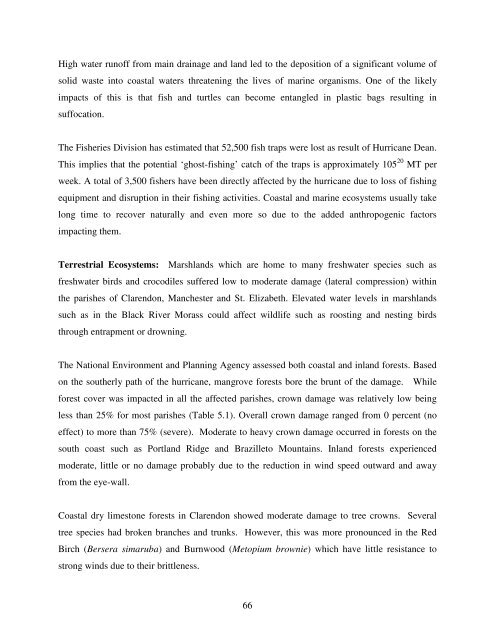assessment of the socio-economic and environmental impact
assessment of the socio-economic and environmental impact
assessment of the socio-economic and environmental impact
Create successful ePaper yourself
Turn your PDF publications into a flip-book with our unique Google optimized e-Paper software.
High water run<strong>of</strong>f from main drainage <strong>and</strong> l<strong>and</strong> led to <strong>the</strong> deposition <strong>of</strong> a significant volume <strong>of</strong><br />
solid waste into coastal waters threatening <strong>the</strong> lives <strong>of</strong> marine organisms. One <strong>of</strong> <strong>the</strong> likely<br />
<strong>impact</strong>s <strong>of</strong> this is that fish <strong>and</strong> turtles can become entangled in plastic bags resulting in<br />
suffocation.<br />
The Fisheries Division has estimated that 52,500 fish traps were lost as result <strong>of</strong> Hurricane Dean.<br />
This implies that <strong>the</strong> potential ‘ghost-fishing’ catch <strong>of</strong> <strong>the</strong> traps is approximately 105 20 MT per<br />
week. A total <strong>of</strong> 3,500 fishers have been directly affected by <strong>the</strong> hurricane due to loss <strong>of</strong> fishing<br />
equipment <strong>and</strong> disruption in <strong>the</strong>ir fishing activities. Coastal <strong>and</strong> marine ecosystems usually take<br />
long time to recover naturally <strong>and</strong> even more so due to <strong>the</strong> added anthropogenic factors<br />
<strong>impact</strong>ing <strong>the</strong>m.<br />
Terrestrial Ecosystems: Marshl<strong>and</strong>s which are home to many freshwater species such as<br />
freshwater birds <strong>and</strong> crocodiles suffered low to moderate damage (lateral compression) within<br />
<strong>the</strong> parishes <strong>of</strong> Clarendon, Manchester <strong>and</strong> St. Elizabeth. Elevated water levels in marshl<strong>and</strong>s<br />
such as in <strong>the</strong> Black River Morass could affect wildlife such as roosting <strong>and</strong> nesting birds<br />
through entrapment or drowning.<br />
The National Environment <strong>and</strong> Planning Agency assessed both coastal <strong>and</strong> inl<strong>and</strong> forests. Based<br />
on <strong>the</strong> sou<strong>the</strong>rly path <strong>of</strong> <strong>the</strong> hurricane, mangrove forests bore <strong>the</strong> brunt <strong>of</strong> <strong>the</strong> damage. While<br />
forest cover was <strong>impact</strong>ed in all <strong>the</strong> affected parishes, crown damage was relatively low being<br />
less than 25% for most parishes (Table 5.1). Overall crown damage ranged from 0 percent (no<br />
effect) to more than 75% (severe). Moderate to heavy crown damage occurred in forests on <strong>the</strong><br />
south coast such as Portl<strong>and</strong> Ridge <strong>and</strong> Brazilleto Mountains. Inl<strong>and</strong> forests experienced<br />
moderate, little or no damage probably due to <strong>the</strong> reduction in wind speed outward <strong>and</strong> away<br />
from <strong>the</strong> eye-wall.<br />
Coastal dry limestone forests in Clarendon showed moderate damage to tree crowns. Several<br />
tree species had broken branches <strong>and</strong> trunks. However, this was more pronounced in <strong>the</strong> Red<br />
Birch (Bersera simaruba) <strong>and</strong> Burnwood (Metopium brownie) which have little resistance to<br />
strong winds due to <strong>the</strong>ir brittleness.<br />
66
















